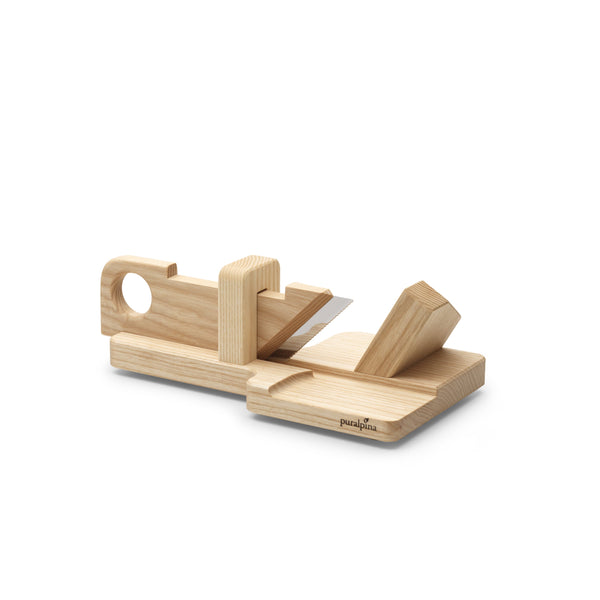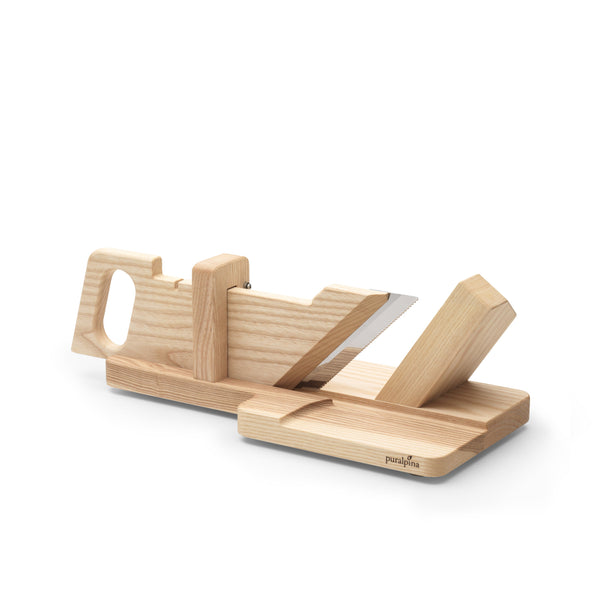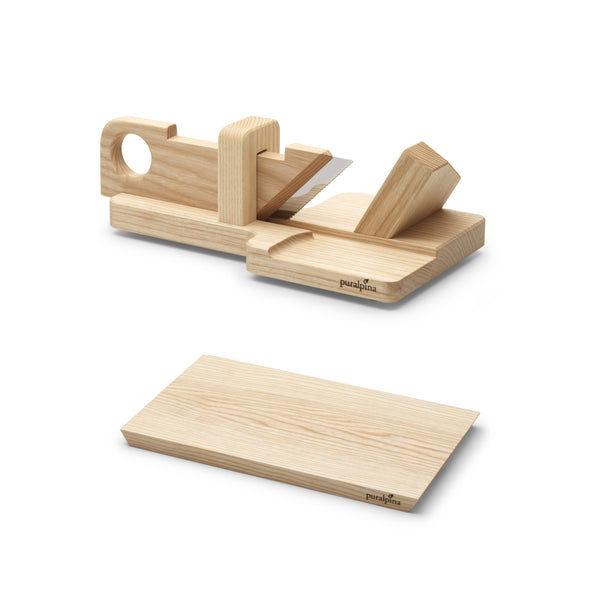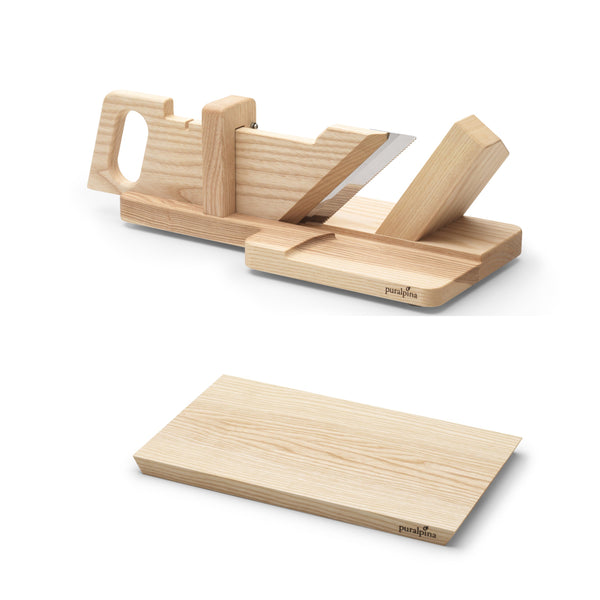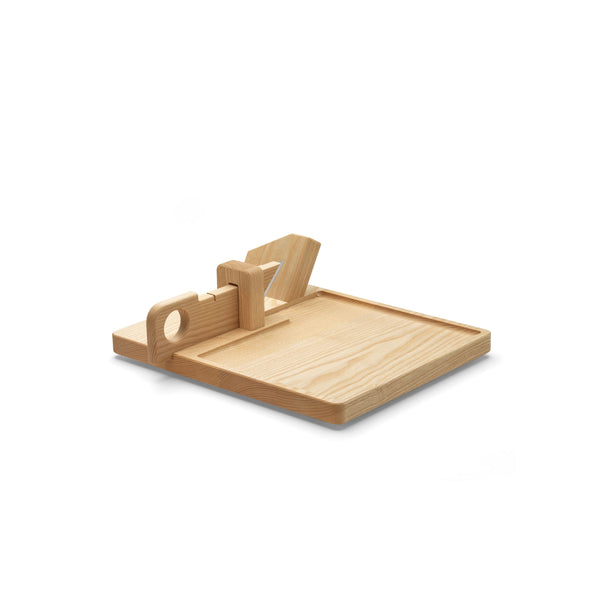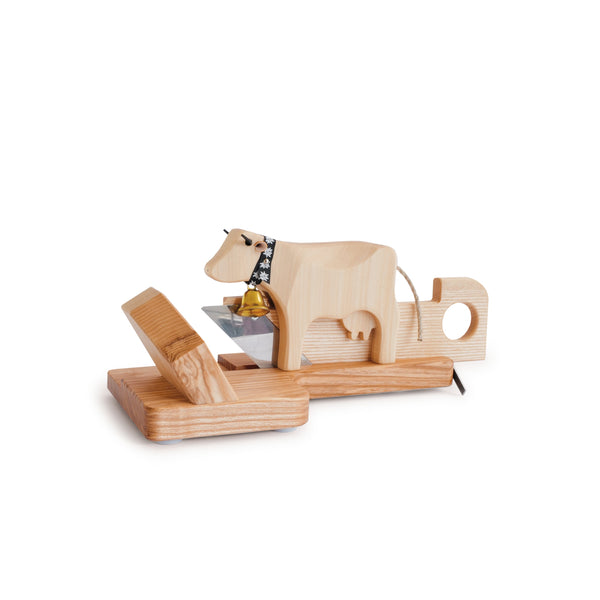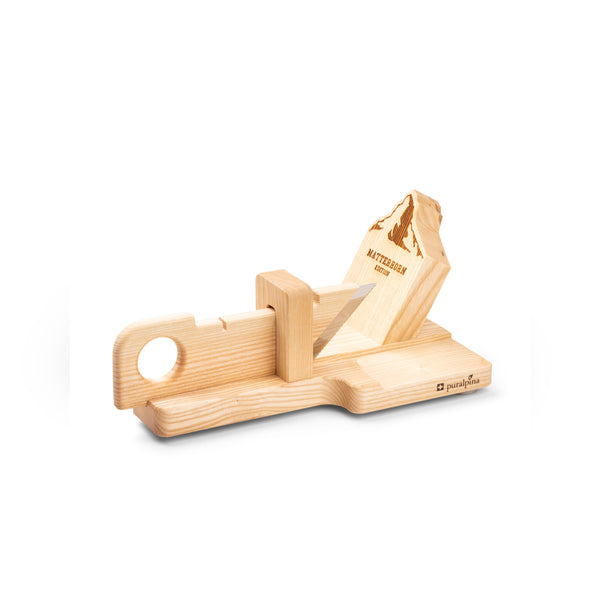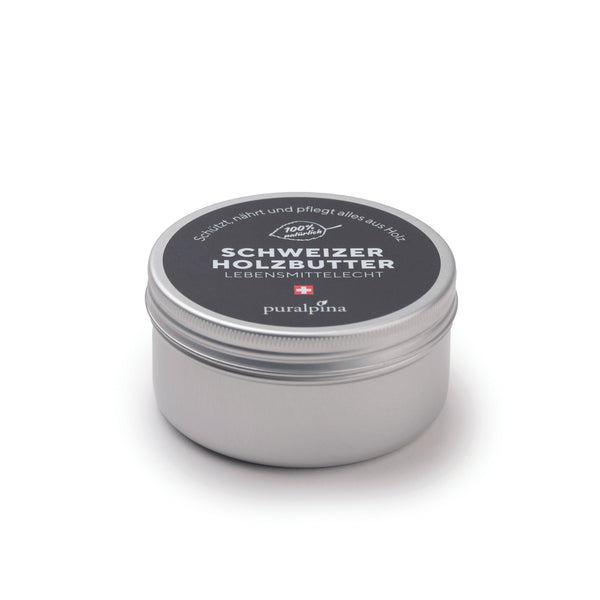Meat slicer for the perfect cut
Easy to use, elegant, and practical. With our unique meat slicers, you can slice sausage, salami, and much more right at your table without electricity. Each of our wooden products is unique, with a distinctive grain, beautifully intergrown knots, and subtle color variations.
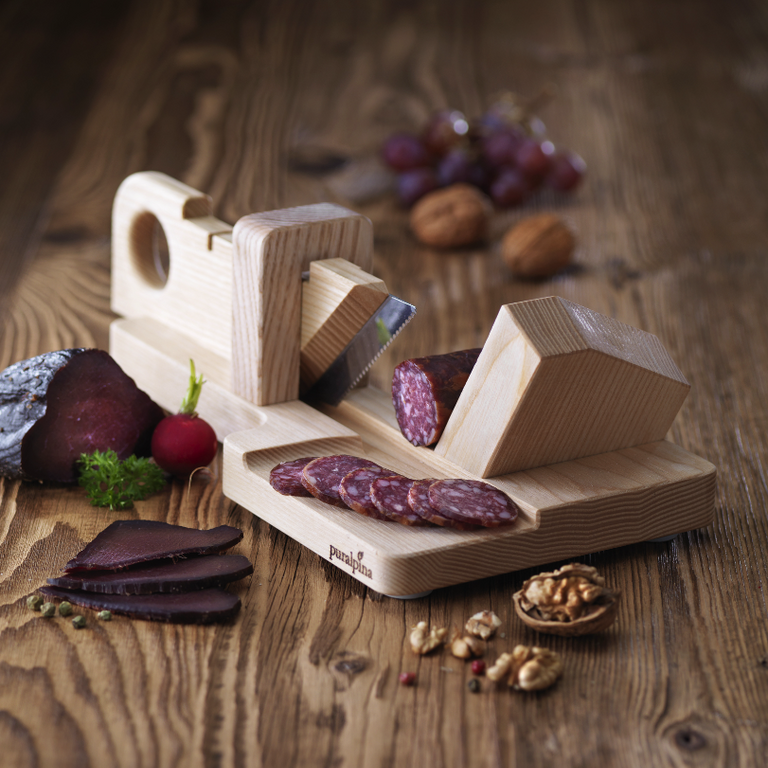
Swiss craftsmanship
All of our meat slicers are manufactured in Swiss workshops for people with disabilities. Our partner workshops are located in Bern and Thun. Through joint planning and development, these unique pieces are crafted with great care, patience, and craftsmanship. The sophisticated mechanism protects both the blade and the wood.
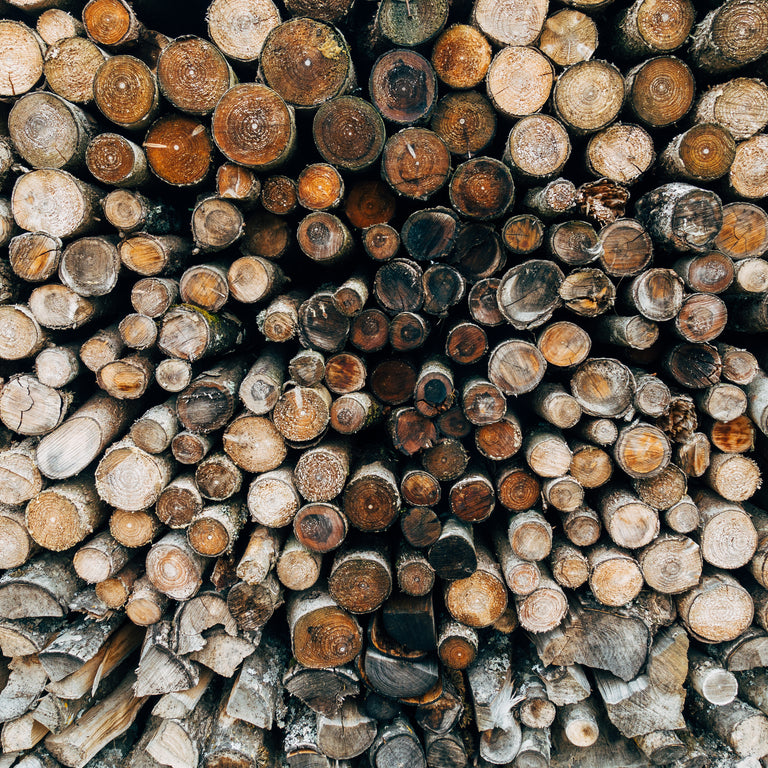
Quality
Our products are crafted from solid wood. The wood comes from ash, walnut, cherry, plum, and olive trees. Each plane is unique, with distinctive grains, beautifully intertwined knots, and subtle color variations. The razor-sharp blade comes from the Swiss knife maker Victorinox. We consider only the highest quality. This pays off for you many times over with its longevity.
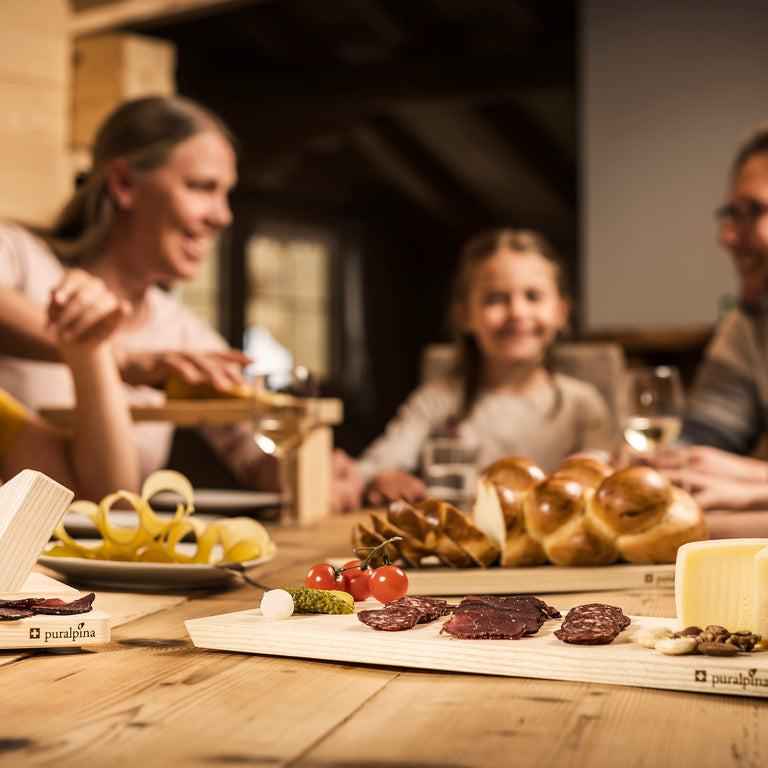
How do meat slicers work?
Our meat slicers are incredibly easy to use. Cutting, adjusting the thickness, cleaning, and changing the blade are child's play.
We show you how to change the blade and how to properly clean and care for the plane in our videos.
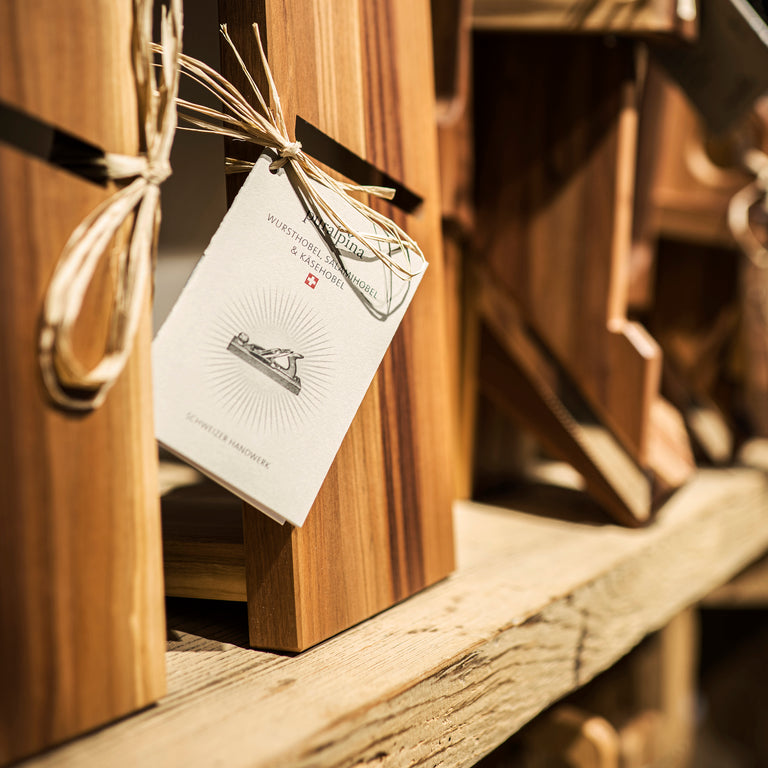
Which plane is right for me?
Sausage slicer
With this slicer you can cut smaller pieces of meat, cheese and sliceable items up to 4.5cm in diameter.
Salami slicer
The salami slicer is suitable for larger pieces of meat and cheese up to 9cm in diameter.
Special editions
A slightly different kind of sausage slicer. Discover our special editions featuring the Trauffer Cow or the Matterhorn.
Meat slicer Gastro
Cutting, presenting, and serving all in one. The meat slicer is available in two versions: the Gastro Sausage Slicer and the Gastro Salami Slicer.

Where does the wood come from?
Whenever possible, we use wood from Switzerland. We attach great importance to contemporary design and a stylish selection of wood species. That's why we're not afraid to source wood from abroad. Here's where our wood comes from:
Ash: Switzerland
Walnut: Mainly from the EU, Hungary. Sourced from: darker black walnut. Swiss walnut is very rare and less suitable for processing.
Cherry tree: Switzerland
Plum tree: Switzerland
Olive tree: mainly from Italy and the EU

Proper care and cleaning
The wooden products should be stored at a constant room temperature, if possible. After use, wipe everything with a damp cloth and dry. Do not clean under water, with a hard brush, or with strong detergents. The wooden products are not dishwasher-safe. If necessary, treat sparingly with food-safe wood oil or cooking oil (such as olive oil). All blades are replaceable or can be sharpened.
Check out our videos on this topic.
Who invented it?
How we would have loved to have invented the sausage slicer. But we weren't. Unfortunately, we don't know where sausage slicers come from. We tried to trace the origin of sausage slicers, but unfortunately, without success. There were many leads pointing in different directions. We even found old plastic versions. We had information that versions of the sausage slicer had been around almost 30 years ago. Well, many say they invented it. Some of them had the slicer in their product range before they invented it.
The salami slicer and the sausage and cheese slicer KOMBI are our developments.
This is our truth
Our first encounter with a sausage slicer happened by chance. A gift from his son Sandro, Andreas Schmid uses the sausage slicer at markets to sample the famous game sausage, without any intention of selling it. It simply makes cutting faster and easier. Customers responded tremendously. Many were enthusiastic and wanted to try it. So, we tracked down the manufacturer of the gifted slicer, and eventually added the sausage slicers to our product range. Soon, more slicers were needed. This is how various workshops for people with disabilities came into play. Some of them had already produced the sausage slicers. Others were newly discovered.
We have continued to invent
But we didn't stop at the sausage slicer; we continued to strive for further developments and improvements. We continually improved the quality of our sausage slicer and, for example, developed the salami slicer. This is the big brother of the sausage slicer for cutting larger pieces of meat. We also combined the sausage slicer and the cheese slicer. This is so unique that we received a patent for our COMBI sausage and cheese slicer.
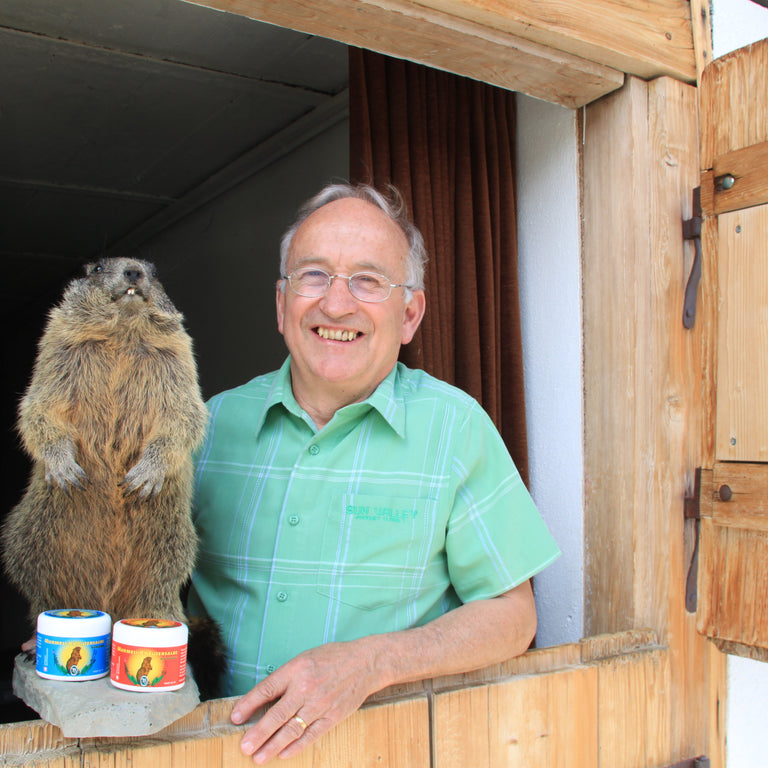
How do plane and marmot ointment fit together?
the whole story
Andreas Schmid is a passionate hunter and has been attending markets as a hobby since 1981, trading furs, marmot oil, and later, game meat. In 1992, a chance meeting with a herbalist led to the creation of the warming marmot herbal ointment. Due to the tremendous success of the marmot herbal ointment, Andreas Schmid began attending more and more markets.
A venison sausage is always included as an additional product. Naturally, this sausage is always sliced and tasted with customers. In 2007, a gifted sausage slicer was introduced to help with cutting the venison sausage. This was done simply because it was faster, as there was no intention of selling it. Customer reactions were so positive, however, that the sausage slicer was added to the product range a year later.
It all originated from hunting. So the marmot herbal ointment and the sausage slicer somehow fit together.
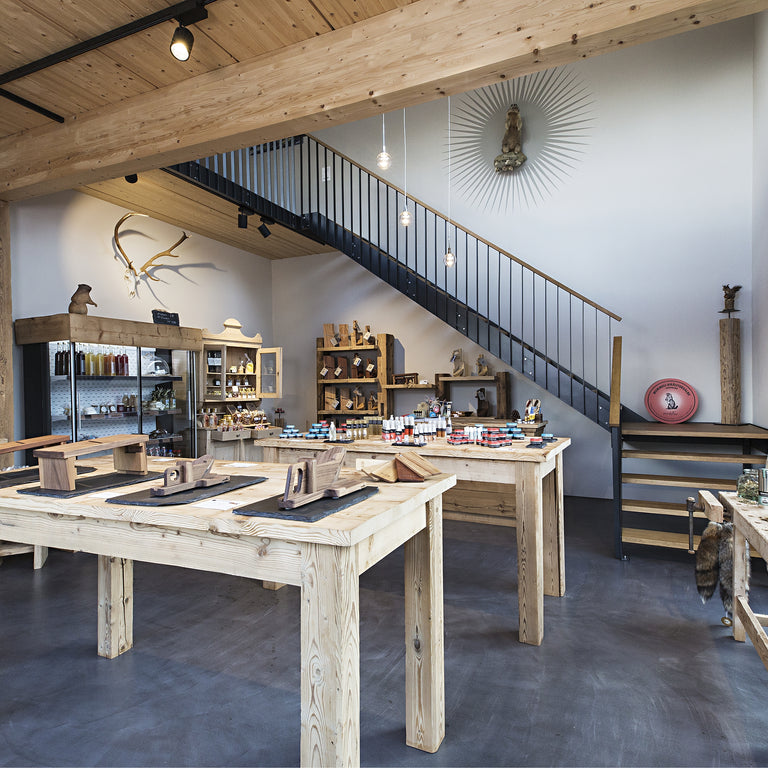
Tip
Looking for a unique gift? These sausage and cheese slicers make perfect gifts for connoisseurs and gourmets, for newlyweds, friends, family, employees, and customers.
Whether it's text or simple logos, you can engrave all of our planes. Just contact us.
Do you have a question?
Here you'll find answers to questions about our meat slicers. If you don't find your answer here, don't hesitate to contact us. We look forward to your question.
Where do the blades come from?
The blades for our sausage slicers, salami slicers and cheese slicers come from the Swiss knife forge of Victorinox.
Over 130 years of tradition and experience guarantee us knives that exactly meet our requirements in terms of sharpness, quality and durability.
Marmot herbal ointments and sausage slicers, how do they go together?
Actually, not at all! But only at first glance. If you know the story behind it, it fits quite well.
Andreas Schmid is a passionate hunter and has been going to markets as a hobby since 1981 to trade in furs, marmot oil and later also game meat. In 1992, a chance meeting with a herbalist led to the creation of the warming marmot herbal ointment. Due to the great success of the marmot herbal ointment, Andreas Schmid is going to more and more markets.
The game sausage is always included as an additional product. Of course, this sausage is always cut and tasted with customers. In 2007, a sausage slicer was given as a gift to help cut the game sausage. Just because it is quicker and without any intention of selling. The reaction from customers was so good, however, that the sausage slicer was added to the range in 2008.
Everything comes from hunting and hunting products. So the marmot herbal ointment and the sausage slicer somehow go together.
How do I care for and store the wooden products?
Store the wooden products at as constant a room temperature as possible. After use, wipe everything with a damp cloth and dry. Do not clean under running water, with a hard brush or strong cleaning agent.
The wooden products are not dishwasher safe. If necessary, you can care for the wood with our 100% natural Swiss wood butter.
The blades are all replaceable or can be sharpened.
Where are the planes and cutting boards made?
The development and production of our sausage slicers, salami slicers, cheese slicers and cutting boards takes place exclusively in Swiss workshops for people with disabilities. These workshops are located in Bern, Thun and Interlaken. Not far from us in Frutigen.
In the workshops, the wooden products are made with patience, dedication, careful craftsmanship and great pride. Each plane and board is unique with its own wood pattern.
Which plane is right for me?
There is no such thing as THE right planer. It all depends on your requirements. We will try to give you a brief explanation here.
SAUSAGE SLICER For smaller pieces of meat, cheese and more. You can cut sausages up to 4.5cm in diameter.
SALAMI SLICER For larger pieces of meat, cheese and anything that can be cut up to 9cm in diameter. If in doubt, use the salami slicer. You can also use it to cut smaller sausages without any problem.
SAUSAGE HARVESTER Gastro At 4.5cm, it has exactly the same cutting surface as the sausage slicer. The only difference is that the sausage slicer is attached to the serving plate.
SALAMI HOBEL Gastro At 9cm, it has exactly the same cutting surface as the salami slicer. The only difference is that the salami slicer is attached to the serving plate.
CHEESE SLICER small Sliced cheese and hard cheese up to 10cm wide.
CHEESE SLICER large Sliced cheese and hard cheese up to 12cm wide. Only with the large cheese slicer can you create the sausage and cheese slicer COMBI together with the sausage slicer.
Where does the wood come from?
Whenever possible and sensible, we use wood from Switzerland. We attach great importance to contemporary design and a stylish selection of wood types. That's why we are not afraid to source wood from abroad.
This is where our wood comes from:
Ash tree Switzerland
Walnut mainly from the EU, mostly Hungary. The reason: darker black walnut tree. Swiss walnut is very rare and less suitable for processing.
Cherry tree Switzerland
Plum tree Switzerland
Olive tree mainly from Italy and the EU
Who invented it?
How we would have loved to have invented the sausage slicer. But we weren't! We never found the origin. Sausage slicers are said to have existed over 30 years ago. Well, many say they invented them. We had the slicer in our range for some of them before they invented it... 😊
This is our truth:
Our first contact with a sausage slicer came about by chance. A gift from his son Sandro, the slicer is used by founder Andreas Schmid at markets to taste the famous wild sausage, without any intention of selling it. It makes cutting quicker and easier. The reaction from customers was great. Many were enthusiastic and wanted to buy the slicer. So the manufacturer of the gifted slicer was sought out and the slicers were eventually added to the range. More slicers were quickly needed. This is how the various workshops for people with disabilities came into play. Some of them had already produced the slicers before. Others were newly discovered.
We have further invented:
But we didn't stop at the sausage slicer, we continued to develop it. The quality of the sausage slicer was continually improved and the salami slicer was created. This is the big brother of the sausage slicer for cutting larger pieces of meat. The patented, and thus protected, sausage and cheese slicer KOMBI was also developed. This combines the sausage slicer and the cheese slicer in a simple, safe and space-saving way.
Can I have an engraving done?
How do I clean the planes?
You can wipe the plane with a damp cloth. This is enough for cleaning. From time to time, a more thorough cleaning is recommended. To do this, you can unscrew the blade and clean everything thoroughly with a damp cloth.
For meat slicers, we recommend that you remove the knife carriage before cleaning. This is for your safety so that you don't cut yourself.
Please do not clean in the dishwasher, under running water or with strong detergent.
Is the planer SUVA compliant?
No, and your meat knife? 😊
Seriously, we hear that from time to time and are always amazed by this question. Yes, it's a knife. Yes, it's sharp. It has to be so that you can cut the meat. It would be difficult with a spoon. And no, it's not more dangerous than other knives. The blade always cuts through in the same place and you can't slip with it. You just can't put your fingers in the same space as the sausage. Then nothing will happen to you. 😊
And by the way: When someone cuts themselves, it's usually when cleaning the plane. Probably because people are less careful there.
How do I adjust the thickness?
You can do this easily by hand and with a little feeling. There is no stop and your pieces will not always be exactly the same thickness, down to a tenth of a millimeter. Unless you are very experienced... 😊 But who needs that for an aperitif with friends?
And anyway, one likes it thicker, the other thinner. So you can just start cutting without having to spend a long time screwing or fixing anything. Each one does it the way she wants.
Believe us, it's really easy and with a little practice you'll quickly get the hang of it. So far, everyone has managed it!
How big pieces can I cut?
Sausage slicer:
Sausages, dried meat, etc. up to 4.5 cm in diameter.
Salami slicer:
Sausages, salami, dried meat, etc. up to 9 cm in diameter.
What can I cut with the planes?
Basically anything you can cut with a knife. Sausages, dried meat, salami, bacon, Mostbröckli, ham, cervelat, cheese, carrots and so on. The blade is made for cutting meat. That works best.
What we do not recommend:
Things that contain water or acid. Such as apples, oranges, lemons. These are not good for the wood and can roughen it.
